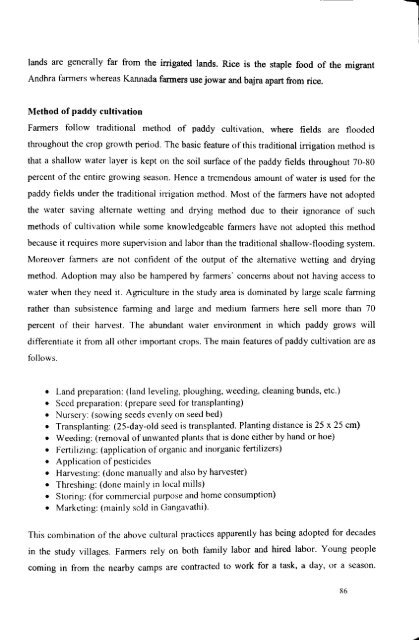Water Users Association and Irrigation Management - Institute for ...
Water Users Association and Irrigation Management - Institute for ...
Water Users Association and Irrigation Management - Institute for ...
Create successful ePaper yourself
Turn your PDF publications into a flip-book with our unique Google optimized e-Paper software.
l<br />
l<strong>and</strong>s are generally far from the irrigated l<strong>and</strong>s. Rice is the staple food of the migrant<br />
Andhra farmers whereas Kannada farmers use jowar <strong>and</strong> bajra apart from rice.<br />
Method of paddy cultivation<br />
Farmers follow traditional method of paddy cultivation, where fields are flooded<br />
throughout the crop growth period. The basic feature of this traditional irrigation method is<br />
that a shallow water layer is kept on the soil surface of the paddy fields throughout 70-80<br />
percent of the entire growing season. Hence a tremendous amount of water is used <strong>for</strong> the<br />
paddy fields under the traditional irrigation method. Most of the farmers have not adopted<br />
the water saving alternate wetting <strong>and</strong> drying method due to their ignorance of such<br />
methods of cultivation while some knowledgeable farmers have not adopted this method<br />
because it requires more supervision <strong>and</strong> labor than the traditional shallow-flooding system.<br />
Moreover farmers are not confident of the output of the alternative wetting <strong>and</strong> drying<br />
method. Adoption may also be hampered by farmers' concerns about not having access to<br />
water when they need it. Agriculture in the study area is dominated by large scale farming<br />
rather than subsistence farming <strong>and</strong> large <strong>and</strong> medium farmers here sell more than 70<br />
percent of their harvest. The abundant water environment in which paddy grows will<br />
differentiate it from all other important crops. The main features of paddy cultivation are as<br />
follows.<br />
• L<strong>and</strong> preparation: (l<strong>and</strong> leveling, ploughing, weeding, cleaning bunds, etc.)<br />
• Seed preparation: (prepare seed <strong>for</strong> transplanting)<br />
• Nursery: (sowing seeds evenly on seed bed)<br />
• Transplanting: (25-day-old seed is transplanted. Planting distance is 25 x 25 em)<br />
• Weeding: (removal of unwanted plants that is done either by h<strong>and</strong> or hoe)<br />
• Fertilizing: (application of organic <strong>and</strong> inorganic fertilizers)<br />
• Application of pesticides<br />
• Harvesting: (done manually <strong>and</strong> also by harvester)<br />
• Threshing: (done mainly in local mills)<br />
• Storing: (<strong>for</strong> commercial purpose <strong>and</strong> home consumption)<br />
• Marketing: (mainly sold in Gangavathi).<br />
This combination of the above cultural practices apparently has being adopted <strong>for</strong> decades<br />
in the study villages. Farmers rely on both family labor <strong>and</strong> hired labor. Young people<br />
coming in from the nearby camps are contracted to work <strong>for</strong> a task, a day, or a season.<br />
R6
















